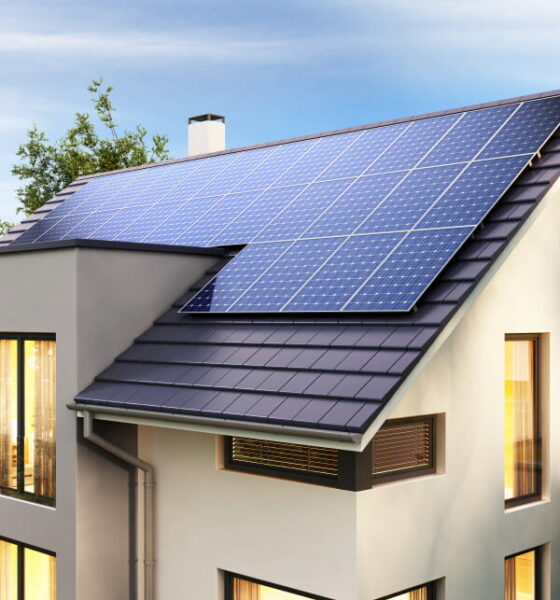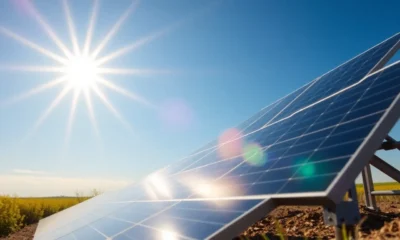

Energy
Ultra Simple Guide to Consumer Solar Panel Installation
Recently, a growing number of people have started to utilize solar power in their homes, because solar energy is a renewable, eco-friendly alternative to traditional electrical systems. The market for solar energy around the world was valued at $52.5 billion in 2018, but is projected to increase to over $223 billion by 2026. This is an annual increase of 20.5%. Not only does this help in cutting down on electricity costs, but it can also make homes safer.
The benefits of solar energy are undeniable. However, a solar power system, or photovoltaic (PV), system isn’t your ordinary DIY project. Installing a PV system takes careful thought, installation, and consumption. But, if you’re planning to add a solar power system in your home, then you’re in the right place.
Fundamentals of a PV System
Before proceeding in purchasing your materials, it’s important to understand what a PV system is and what it’s composed of first. The solar power system is responsible for converting the harnessed solar energy from the sun into electricity that can be utilized by your appliances.
The following are the components of a PV system:
- Cell: The basic building block of your PV system
- Module: When two or more cells are connected, this has a power output of 10–300 watts
- Inverter: Connected to your modules, converts system’s DC to AC
- Batteries (optional): In case of power interruptions, batteries can provide backup power to the system
Assessing Your Property for a PV System Installation
There are a few considerations in installing a solar power system into your home. Therefore, it’s paramount to assess your average energy consumption, solar power potential according to your location, roof or yard structure, and return of investment. You may be wondering how many solar panels are needed to power an average house, but it can vary greatly on your needs and preferences.
Is your home fit for a solar panel installation? Check out these criteria below:
- The location of your home gets an acceptable amount of sunlight all year round.
- There’s enough space in your home to install the PV system, which can be on your roof or yard. Starter systems usually range from 50 square feet, while households and commercial properties with larger energy consumption can reach as much as 1,000 square feet.
- Your desired installation area must have a clear view of the sun in different times of the day, without any obstructions such as buildings, trees, chimneys, and the like.
- Your roof should be in a good condition. If you’re considering having an eco-friendly roof replacement soon, it would be a better idea to replace it along with the PV system installation.
You will have a much easier time setting up your solar system if you follow the steps outlined above.
DIY vs. Professional Solar Power Installation
In DIY installation, you can save money on labor costs and have the project started whenever you want. However, if you don’t have sufficient experience in electrical work, you may find the PV system setup complicated. Also, you can’t connect to the power grid in your area, then you have to make sure that your PV system can support all your electrical needs.
On another end, you can guarantee quality work from the professionals but in exchange for a great sum of money. You’ll also be able to connect to the power grid and have the PV provider coordinate with your electricity provider, as well as obtain warranty in case of any installation issues. If your PV system project needs more expertise and attention to detail, hiring a solar power company is recommended.
How Much Will You Save?
The main highlight of welcoming solar panels into your home is to save your money from high electricity bills and make the most out of the solar energy available. The size of your PV system against your electricity consumption will highly determine how much you’ll save in the long run. You can either choose to go 100% solar, or use it partially for your electricity needs.
To assess how large your PV system should be, you can ask assistance from your PV provider in evaluating your past electricity consumptions and work out how much energy is needed to achieve your electricity needs. Additionally, integrating a battery system for energy storage can add value to your system, but makes your installation more expensive.
To determine your PV system’s worth of energy generation, it will depend on your current electricity cost and how much your electricity provider will pay you for any excess power generated by your system. Since these values vary greatly depending on your geographic location, quality of components and installation, and more, it’s best to discuss it with your PV and electricity provider.
Obtaining Permits for Installation
Most of the state and country laws encourage the rights of homeowners to install their own PV system—but you’ll probably have to obtain permits from your city department, which your PV provider will take care of. The code requirements for installing a solar power system are primarily based on the National Electrical Code (NEC) in Article 690, highlighting the requirements in designing and installing a PV system that’s safe, reliable, and compliant with building codes.
Implementing Your Solar System Takes Thought and Preparation
A solar power system should last for years of use, so you must make sure that you’re installing them with safety, quality, and environmental value. If you’re shifting your path to using solar power systems, this guide can help you in deciding if installing one is really right for you, and steps on how you can install your solar power system in an efficient and eco-friendly way.


 Environment9 months ago
Environment9 months agoAre Polymer Banknotes: an Eco-Friendly Trend or a Groundswell?

 Environment11 months ago
Environment11 months agoEco-Friendly Home Improvements: Top 7 Upgrades for 2025

 Features8 months ago
Features8 months agoEco-Friendly Cryptocurrencies: Sustainable Investment Choices

 Features10 months ago
Features10 months agoEco-Friendly Crypto Traders Must Find the Right Exchange





























